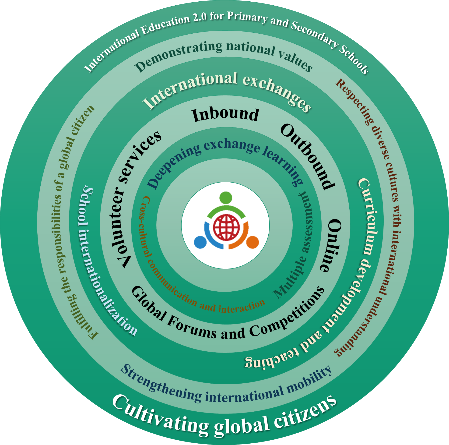The international exchanges project aims at cultivating global citizens with four aspects and its development is inseparably interconnected to curriculum and teaching of international education and school internationalization. For integrating international education into various subject areas, schools can implement international education courses through different types of international exchanges, and focus on deepening exchange learning, intercultural communication, and multiple assessment.

Key Points for Exchange project Development
- Deepening exchange learning:
When planning international exchange activities, it is important to go beyond superficial visits. Exchange activities should be designed and guided through curriculum planning to deepen the learning content. For example, in the case of in-class learning during visits, students can have an immersive experience of the local classroom culture, engage in discussions with foreign students, and participate in classroom tasks. Through in-class learning, students can use their communication skills to become aware of cultural differences and gradually cultivate their international perspective. By deepening students' international outlook, exchange activities become more meaningful. - Cross-cultural communication and interaction:
Cross-cultural communication and interaction involve cross-cultural understanding and communication. Cross-cultural understanding is the process in which people from different cultural backgrounds communicate and understand each other's messages, knowledge, and emotions. It is an important aspect of international exchange to learn how individuals from different cultures face differences, reduce prejudice and discrimination, and achieve mutual understanding and collaboration. In the process of communication and interaction, students not only rely on their own cultural habits, concepts, and behaviors but also experience and understand the culture of others. Teachers can design learning materials and feedback activities to encourage students to engage in cross-cultural reflection and deepen their communication strategies. Through cross-cultural understanding and the application of communication skills, students can develop an appreciation and respect for different cultures, ultimately fostering global citizenship. - Multiple Assessment Methods:
Assessment designs should be specific and authentic in capturing students' multidimensional performance and abilities. Utilizing various assessment methods and implementing them appropriately in conjunction with exchange activities is crucial for reflecting students' competencies demonstrated throughout the curriculum. Therefore, in addition to employing diverse assessment approaches, it is important for teachers to appropriately plan formative and summative assessments and strike a balance between different types of assessment outcomes. This emphasis on comprehensive assessment implementation is essential for fostering a multifaceted evaluation of students' achievements.





